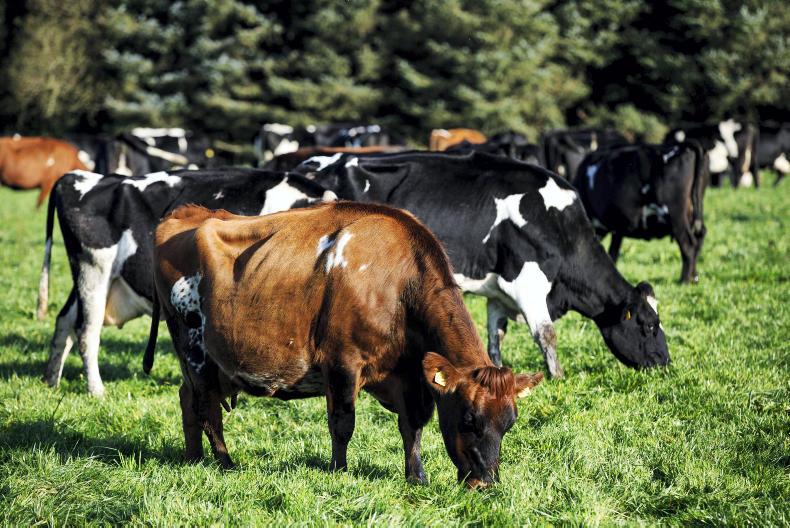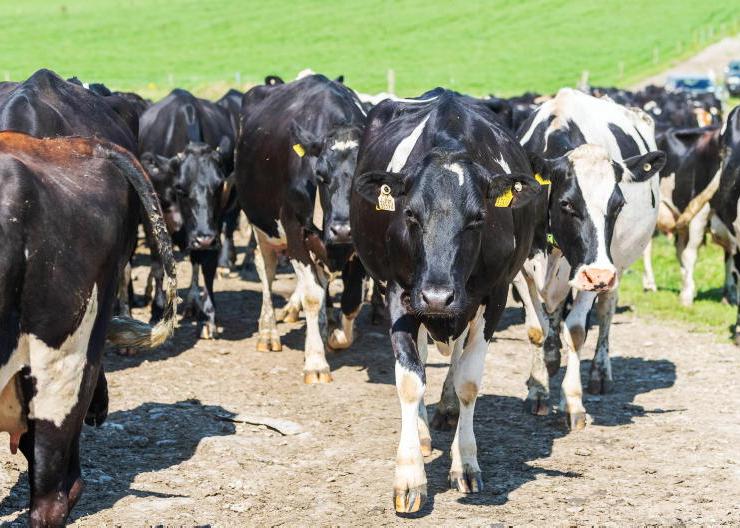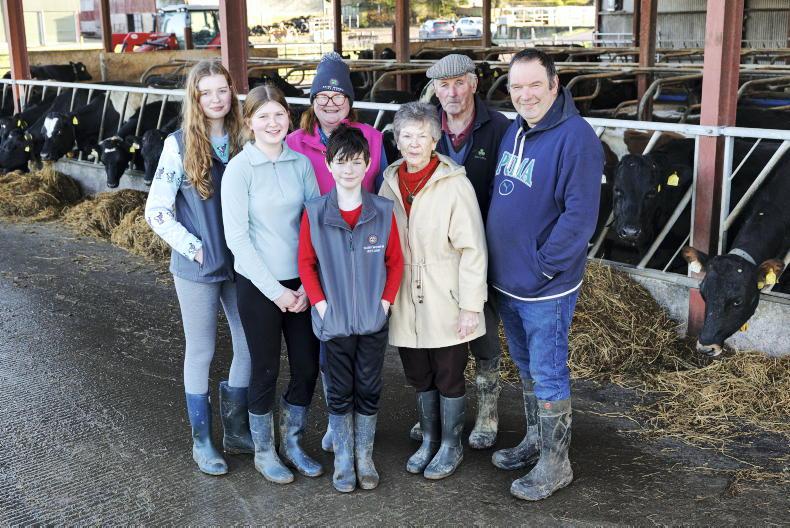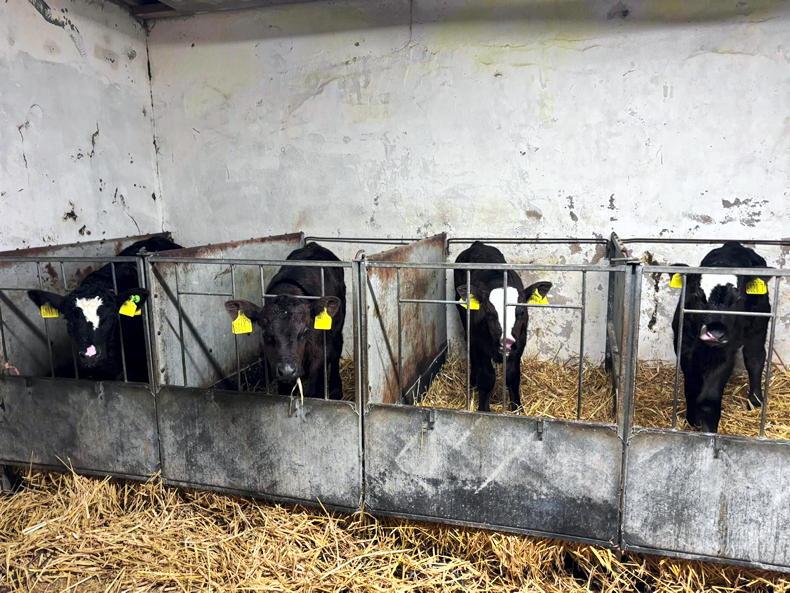From 2000 to 2010 when ranking the Irish dairy herd on EBI, cows with Jersey crossbred genes had a €100 higher EBI when compared to the other breeds.
This tells us that the average Jersey-crossbred cow was predicted to be €100 more profitable per lactation in comparison with the black-and-white breeds. This is before hybrid vigour, which is estimated to be worth another €100 in extra profit, is considered.
Since 2010, the rate of genetic gain for EBI within the black-and-white breeds has increased at a faster rate than that of Jerseys.
According to recent analysis by Andrew Cromie, ICBF, for the first time cows bred from a Holstein Friesian sire have a similar EBI to those from a predominately Jersey sire. The EBI of first-lactation cows in both breeds is now the same at around €160.
Rate of gain
All breeds have achieved genetic gain over the last 20 years, but the rate of gain for the Holstein breed started ramping up around 10 years ago, coinciding with the introduction of the Gene Ireland young bull testing programme and genomic selection.
For the most part, Jersey bulls are just not able to match Holstein Friesian bulls when it comes to genetic gain in EBI terms
Andrew Cromie expects this rate of gain for the Holstein Friesian breed to continue and that they will surpass Jersey-crossbred cows as being the breed with the highest EBI in the next two to three years. This should come as no real surprise, because Holstein Friesian bulls have been dominating the top of the active bull list for the last decade.
For the most part, Jersey bulls are just not able to match Holstein Friesian bulls when it comes to genetic gain in EBI terms.
So where does this leave the Jersey-crossbred cow? Are the aficionados of crossbreeding soon to be what the Holstein Friesian pedigree breeders were of the 2000s – determined to continue breeding the cow that they like, rather than the cow that’s most profitable?
Or is there something that these cows are delivering that is not fully captured in the EBI? We know that heterosis or hybrid vigour is not accounted for in the EBI and is difficult to quantify. However, a new report by the ICBF suggests that maybe there isn’t that much difference between the breeds.
Data
The ICBF Mythbusters analysis looked at the performance of all spring-calving herds split between herds with no Jersey genetics (8,625 herds) and herds that are mainly crossbreeding (389 herds).
Results of this analysis (Table 1) showed that Holstein Friesian herds had an average milk receipts per cow of €1,807 and a 66% six-week calving rate compared with milk receipts of €1,870 and a six-week calving rate of 80% for the mainly-crossbred herds.
The next step was to compare performance for larger herds of between 150 and 300 cows
Herds that are mainly crossbred have an average of 31% Jersey genetics in the herd. If the study was left at that, it would show the Jersey cross as the better fertility, higher-profit choice.
The next step was to compare performance for larger herds of between 150 and 300 cows. Andrew said this was to illustrate herd performance under slightly tougher conditions, with longer walks to paddocks, more competition for feed, potentially longer milking times, etc.
By just looking at larger herd size, the number of herds in the study reduced to 873 Holstein Friesian herds and 130 crossbred herds.
This set of data (Table 2) showed that Holstein Friesian cows generated an average of €1,967 in milk receipts and had a six-week calving rate of 69%. The Jersey crossbred cows had lower milk receipts at €1,919 per cow, but had a higher six-week calving rate of 83%.
The next step was to break the data down further and just look at high-EBI herds within both categories. Andrew said the thinking there was that the performance of the top-EBI herds is indicative of the future performance of the national herd, because this is the direction the national herd is going in. Only herds in the top 10% of all herds in the country got to the next stage.
Of the 873 Holstein Friesian herds, 113 fell into the top 10% category with an EBI of €155, while 90 of the 130 crossbred herds in the top 10% category had an EBI of €161.
Cows in Holstein Friesian herds are delivering 501kg MS/cow, which is a milk receipts figure of €2,120/cow
This dataset of 203 herds is presented in Table 2 and shows that the Holstein Friesian herds are outperforming the crossbred herds in most parameters, but particularly in milk solids and, consequently, milk receipts per cow.
Cows in Holstein Friesian herds are delivering 501kg MS/cow, which is a milk receipts figure of €2,120/cow.
This is 44kg MS/cow and €202/cow greater than cows in herds that are predominately crossbred.
Better fertility
The six-week calving rate at 84% for the crossbred herds was 2% higher than that achieved by the black-and-white herds.
However, it’s fair to say that better fertility should transfer to better production, but, based on these figures, the Holstein Friesian cows had a better ability to produce milk solids, despite a slightly reduced fertility performance.
Now, as farmers will be well aware, yield has a weak correlation to profit, so just because one breed produced more, doesn’t make that breed more profitable. For example, that extra 44kg milk solids could be produced by feeding a lot more concentrate or from cows that are much larger, therefore requiring a lot of extra feed or a much lower stocking rate.
Based on their EBI maintenance sub-index, Andrew says the black-and-white cows are predicted to weigh between 580kg and 600kg, while the crossbreds are predicted to weigh between 500kg and 520kg. This is a difference of 80kg liveweight (LWT).
Thirty-eight of the 90 crossbred herds and 37 of the 113 black-and-white herds had completed profit monitors
In terms of efficiency, the black-and-white cows produced 0.85kg MS/kg LWT, while the crossbred cows produced 0.9kg MS/kg LWT.
To investigate if this had an impact on profit, 2019 profit monitor data for 77 of the 203 herds was analysed.
Thirty-eight of the 90 crossbred herds and 37 of the 113 black-and-white herds had completed profit monitors.
This data showed that the crossbred herds ran a slightly higher stocking rate, with a slightly lower gross output per hectare, slightly lower costs per hectare and a slightly lower profit per hectare than black-and-white herds.
Net profit for the black-and-white herds was €2,161/ha, while it was 6% or €120/ha lower for the crossbred herds at €2,041/ha.
This report raises a couple of questions.
Firstly, where is the hybrid vigour from crossbreeding? If both groups have similar EBI, the crossbred herds should be outperforming the Holstein Friesian herds. Secondly, is this a reliable comparison and would it stand up to independent expert scrutiny? Is it fair to compare the top 1% of Holstein Friesian herds with the top 23% of Jersey crossbred herds? Has the fact that some crossbred herds are once-a-day been considered?
Is this not a comparison study, rather a reflective lookback at a select number of herds without knowing herd inputs? Thirdly, does this new information agree or disagree with previous peer-reviewed research in genetics for profitable milk production systems?
What is clear is that high-EBI Holstein Friesian cows are able to deliver for farmers, but it’s not clear if crossbreeding is dead.
Read more
Managing May grass for high milk solids
Follow the milk money trail: how farmers get paid for their work
From 2000 to 2010 when ranking the Irish dairy herd on EBI, cows with Jersey crossbred genes had a €100 higher EBI when compared to the other breeds.
This tells us that the average Jersey-crossbred cow was predicted to be €100 more profitable per lactation in comparison with the black-and-white breeds. This is before hybrid vigour, which is estimated to be worth another €100 in extra profit, is considered.
Since 2010, the rate of genetic gain for EBI within the black-and-white breeds has increased at a faster rate than that of Jerseys.
According to recent analysis by Andrew Cromie, ICBF, for the first time cows bred from a Holstein Friesian sire have a similar EBI to those from a predominately Jersey sire. The EBI of first-lactation cows in both breeds is now the same at around €160.
Rate of gain
All breeds have achieved genetic gain over the last 20 years, but the rate of gain for the Holstein breed started ramping up around 10 years ago, coinciding with the introduction of the Gene Ireland young bull testing programme and genomic selection.
For the most part, Jersey bulls are just not able to match Holstein Friesian bulls when it comes to genetic gain in EBI terms
Andrew Cromie expects this rate of gain for the Holstein Friesian breed to continue and that they will surpass Jersey-crossbred cows as being the breed with the highest EBI in the next two to three years. This should come as no real surprise, because Holstein Friesian bulls have been dominating the top of the active bull list for the last decade.
For the most part, Jersey bulls are just not able to match Holstein Friesian bulls when it comes to genetic gain in EBI terms.
So where does this leave the Jersey-crossbred cow? Are the aficionados of crossbreeding soon to be what the Holstein Friesian pedigree breeders were of the 2000s – determined to continue breeding the cow that they like, rather than the cow that’s most profitable?
Or is there something that these cows are delivering that is not fully captured in the EBI? We know that heterosis or hybrid vigour is not accounted for in the EBI and is difficult to quantify. However, a new report by the ICBF suggests that maybe there isn’t that much difference between the breeds.
Data
The ICBF Mythbusters analysis looked at the performance of all spring-calving herds split between herds with no Jersey genetics (8,625 herds) and herds that are mainly crossbreeding (389 herds).
Results of this analysis (Table 1) showed that Holstein Friesian herds had an average milk receipts per cow of €1,807 and a 66% six-week calving rate compared with milk receipts of €1,870 and a six-week calving rate of 80% for the mainly-crossbred herds.
The next step was to compare performance for larger herds of between 150 and 300 cows
Herds that are mainly crossbred have an average of 31% Jersey genetics in the herd. If the study was left at that, it would show the Jersey cross as the better fertility, higher-profit choice.
The next step was to compare performance for larger herds of between 150 and 300 cows. Andrew said this was to illustrate herd performance under slightly tougher conditions, with longer walks to paddocks, more competition for feed, potentially longer milking times, etc.
By just looking at larger herd size, the number of herds in the study reduced to 873 Holstein Friesian herds and 130 crossbred herds.
This set of data (Table 2) showed that Holstein Friesian cows generated an average of €1,967 in milk receipts and had a six-week calving rate of 69%. The Jersey crossbred cows had lower milk receipts at €1,919 per cow, but had a higher six-week calving rate of 83%.
The next step was to break the data down further and just look at high-EBI herds within both categories. Andrew said the thinking there was that the performance of the top-EBI herds is indicative of the future performance of the national herd, because this is the direction the national herd is going in. Only herds in the top 10% of all herds in the country got to the next stage.
Of the 873 Holstein Friesian herds, 113 fell into the top 10% category with an EBI of €155, while 90 of the 130 crossbred herds in the top 10% category had an EBI of €161.
Cows in Holstein Friesian herds are delivering 501kg MS/cow, which is a milk receipts figure of €2,120/cow
This dataset of 203 herds is presented in Table 2 and shows that the Holstein Friesian herds are outperforming the crossbred herds in most parameters, but particularly in milk solids and, consequently, milk receipts per cow.
Cows in Holstein Friesian herds are delivering 501kg MS/cow, which is a milk receipts figure of €2,120/cow.
This is 44kg MS/cow and €202/cow greater than cows in herds that are predominately crossbred.
Better fertility
The six-week calving rate at 84% for the crossbred herds was 2% higher than that achieved by the black-and-white herds.
However, it’s fair to say that better fertility should transfer to better production, but, based on these figures, the Holstein Friesian cows had a better ability to produce milk solids, despite a slightly reduced fertility performance.
Now, as farmers will be well aware, yield has a weak correlation to profit, so just because one breed produced more, doesn’t make that breed more profitable. For example, that extra 44kg milk solids could be produced by feeding a lot more concentrate or from cows that are much larger, therefore requiring a lot of extra feed or a much lower stocking rate.
Based on their EBI maintenance sub-index, Andrew says the black-and-white cows are predicted to weigh between 580kg and 600kg, while the crossbreds are predicted to weigh between 500kg and 520kg. This is a difference of 80kg liveweight (LWT).
Thirty-eight of the 90 crossbred herds and 37 of the 113 black-and-white herds had completed profit monitors
In terms of efficiency, the black-and-white cows produced 0.85kg MS/kg LWT, while the crossbred cows produced 0.9kg MS/kg LWT.
To investigate if this had an impact on profit, 2019 profit monitor data for 77 of the 203 herds was analysed.
Thirty-eight of the 90 crossbred herds and 37 of the 113 black-and-white herds had completed profit monitors.
This data showed that the crossbred herds ran a slightly higher stocking rate, with a slightly lower gross output per hectare, slightly lower costs per hectare and a slightly lower profit per hectare than black-and-white herds.
Net profit for the black-and-white herds was €2,161/ha, while it was 6% or €120/ha lower for the crossbred herds at €2,041/ha.
This report raises a couple of questions.
Firstly, where is the hybrid vigour from crossbreeding? If both groups have similar EBI, the crossbred herds should be outperforming the Holstein Friesian herds. Secondly, is this a reliable comparison and would it stand up to independent expert scrutiny? Is it fair to compare the top 1% of Holstein Friesian herds with the top 23% of Jersey crossbred herds? Has the fact that some crossbred herds are once-a-day been considered?
Is this not a comparison study, rather a reflective lookback at a select number of herds without knowing herd inputs? Thirdly, does this new information agree or disagree with previous peer-reviewed research in genetics for profitable milk production systems?
What is clear is that high-EBI Holstein Friesian cows are able to deliver for farmers, but it’s not clear if crossbreeding is dead.
Read more
Managing May grass for high milk solids
Follow the milk money trail: how farmers get paid for their work









SHARING OPTIONS